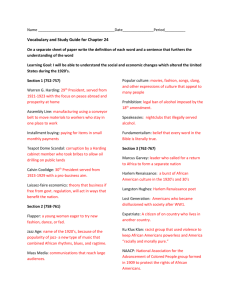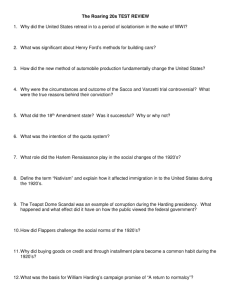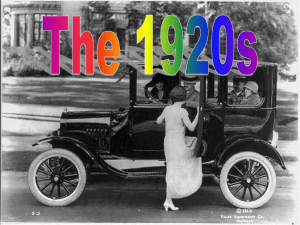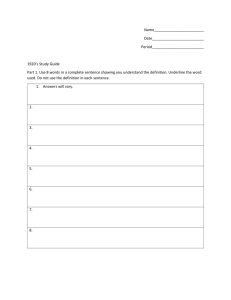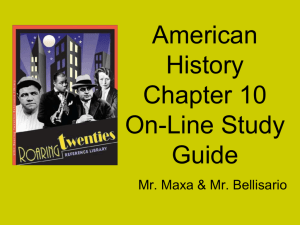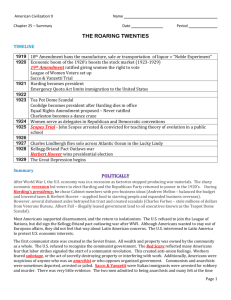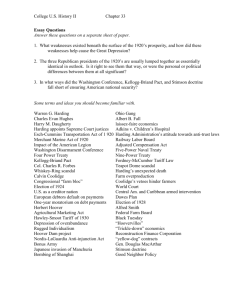Chapter 22 The Roaring Twenties (1919
advertisement
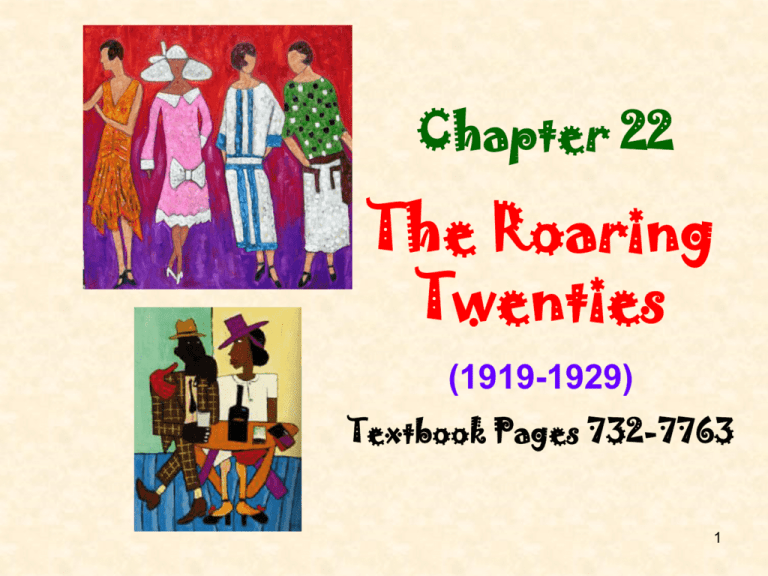
Chapter 22 The Roaring Twenties (1919-1929) Textbook Pages 732-7763 1 1.Politics and Prosperity Warren G. Harding was elected as the new President in 1921. World War I helped the economy. Factories expanded rapidly to meet the need for military supplies. When the war was over more than 2 million soldiers came home looking for jobs. At the same time factories stopped turning out materials. The result was a sharp recession, or economic slump. Warren G. Harding Dorothea Lange's Migrant Mother depicts destitute pea pickers in California, centering on Florence Owens Thompson, a mother of seven children, age 32, in Nipomo, California, March 1936. 2 Harding filled his cabinet positions with his old friends. This created a scandal. (conduct that brings disgrace or offense). Many believed Harding’s sudden death was attributed to the many scandals during his presidency. In the Teapot Dome Scandal (a bribery incident that took place in the United States from 1921 to 1922) the first cabinet official was sent to prison for being involved in an oil bribery. On the day Harding died, Calvin Coolidge, the Vice President became the new President. Calvin Coolidge Calvin Coolidge Doheny (2nd from right) testifying before the Senate Committee investigating the Tea Pot Oil Leases 3 Coolidge set out to repair the damage caused by the scandals. Coolidge cut regulations on business to make the country prosper. As a result industry had a rapid economic growth. As a result there were more jobs and incomes rose. To encourage the buying of products, businesses allowed installment buying, or buying on credit. 4 Buying on credit led to a soaring stock market. Corporations sold stocks, or shares of ownership, to investors. Investors made or lost money depending on whether the price of the shares went up or down. A period of increased stock trading or the rising of stock prices is known as a bull market. The New York Stock Exchange 5 The Soviet Union set up a government called communism. Communism is an economic system in which all wealth and property is owned by the community. Americans refused to recognize this government started by a man named Lenin. Most Americans disliked Communism. An Arms race was one of the Causes of World War I. Many Americans were in favor of a disarmament of Europe. A disarmament of weapons is a reduction of weapons. Lenin The Soviet Flag 6 2. New Ways of Life Prohibition began in the 1920’s. Prohibition was the ban on the manufacture, sale, and transportation of liquor any where in the United States. Supporters of prohibition were overjoyed. Soon the Eighteenth Amendment went into affect. It banned the use of liquor in the United States. Liquor was banned in the United States. Eighteenth Amendment 7 Click on picture to learn more about smugglers Twenty First Amendment Many Americans found ways to get around the law. People manufactured their own liquor in their own homes to get around the law. Smugglers hid bottles in their own boots, they became known as bootleggers. Organized crime took a great boost by providing liquor for every illegal speak-easy. Soon in 1933 the United States ratified the Twenty First Amendment which repealed, or cancelled the Eighteenth Amendment. 8 Another Amendment that changed American lives was the Nineteenth Amendment. Ratified in 1920, it gave women the right to vote. The league of women voters was set up to help educate the voters. Suffragettes 9 Soon women served as delegates in the Republican and Democratic conventions. In 1924 two women governors were elected, Nellie Tayloe Ross and Miriam A. Ferguson. Women of the suffrage movement also worked to pass the Equal Rights Amendment. The Equal Rights Amendment stated that no rights shall be denied or abridged by the United States based on account of being a man or a woman. Nellie Tayloe Ross 10 Equal Rights Amendment Life had changed for women during World War I. Many women worked outside of their homes. When the troops returned home many women remained working outside of their home. Many bought ready made dresses. Electric appliances such as refrigerators and washing machines made life easier for women. Women helped support the 11 soldiers in WWI The invention of the automobile had a great impact on Americans in the 1920’s. Car sales grew rapidly during this period. Americans traveled to more places then ever before thanks to the automobile. The cost of the Model T dropped from $850 to $290. As a result, Americans do not need to be rich to buy a car. Car prices also fell because factories became more efficient. Henry Ford and the Model T Model T 12 With the low cost of the automobile, people moved to the outside of cities, called suburbs. A suburb is a community located outside the city. With cars people could drive to their job in the city even though it was miles away. A suburb 13 Radios became very popular in the 1920’s. More than ten million families owned radios and listened to broadcasts. Millions of Americans went to the movies. The first movies had no sound and were in black and white. A pianist played music that went with the action. An early radio 14 3. The Roaring Twenties During the 1920’s new dances, new music, new games and other new ways of fun swept the country. New fads caught on in the country. A fad is an activity or fashion that is taken up with great passion for a short time. Dances and crazes came and went rapidly. Young women known as flappers rebelled against the traditional ways of thinking and acting. flappers 15 Louis Armstrong Another innovation in the 1920’s was jazz. Born in New Orleans, jazz combined West African rhythms. Louis Armstrong was one of the brilliant young African American musicians who helped create jazz 16 New writers earned worldwide fame in the 1920’s. Ernest Hemingway wrote of his war experiences in a novel called A Farewell to Arms. The novel is about a young mans disgust for the war. Ernest Hemingway 17 Duke Ellington and his orchestra W.E.B. Du Bois was a famous writer of the Harlem Renaissance In the 1920’s, large numbers of African American musicians, artists, and writers settled in Harlem. This period of time became known as the Harlem Renaissance. During the Harlem Renaissance young black artists celebrated their African and American heritage. 18 Langston Hughes was the best known poet of the Harlem Renaissance. He published his first poem, The Negro Speaks of Rivers. Langston Hughes 19 Athletes such as Jack Dempsey, Bill Tilden, and Helen Wills became famous during the 1920’s. Charles Lindbergh flew a plane from New York across the Atlantic Ocean. He was known as “Lucky Lindy.” Bill Tilden Charles Lindbergh Jack Dempsey 20 4. A Nation Divided In 1929 the average family earned $2000.00 a year. Their was trouble with prosperity. a successful, flourishing, or thriving condition Workers were hurt by the changes in industry. Shorter skirts meant less material needed to be produced. Coal miners lost their jobs as oil became a new source of energy. Trains began losing business to the trucking industry. Farmers were hit the hardest during World War I. Europeans bought products from the farmers. After World War I they stopped buying the farmers products. The farmers could not pay off their loans after the war so they lost their farms. A farmer in 1929 21 After World War I workers demanded higher pay. Strikes broke out around the country. Judges limited the rights of unions in the courts. Company's created company unions or labor organizations that were controlled by the management. 22 John D. Rockefeller Anarchist’s symbol With the rise of communism many Americans were on alert for secret spies that would sabotage, or secretly destroy property . Many people known as anarchists opposed the organized government in America. Many anarchists plotted to kill many well known Americans such as John D. Rockefeller. Many foreigners were deported, or expelled from the country. There were anti-foreign feelings, known as nativism that developed among Americans. Congress responded by setting up the quota system. In the quota system only a certain number of immigrants were allowed to enter from each country into the United States. 23 Scopes Trial Theory of Evolution In the Scopes Trial the clash between old and new values erupted. Darwin’s Theory of Evolution was on trial. Churches condemned Darwin's Theory. As a result of the trial the teaching of evolution was condemned in schools, although it is rarely enforced today. 24 A new organization called the Klu Klux Klan began in 1915. The original Klan kept African Americans from voting during the Civil War. Now The Klan had a broader aim: to preserve the United States for white, native-born Protestants. The Klan terrorized immigrants and African Americans by using lynching and burning crosses on front lawns. Klu Klux Klan 25 After coming back from World War I African Americans returned back to a segregated society. Racial prejudice was widespread through the United States. Marcus Garvey became a popular black leader. He started a black nationalist movement. Marcus Garvey (far right) in parade Marcus Garvey 26 In the election of 1928 Herbert Hoover became the new President of the United States of America. He was the 31st President of the United States. Herbert Hoover 27 28
